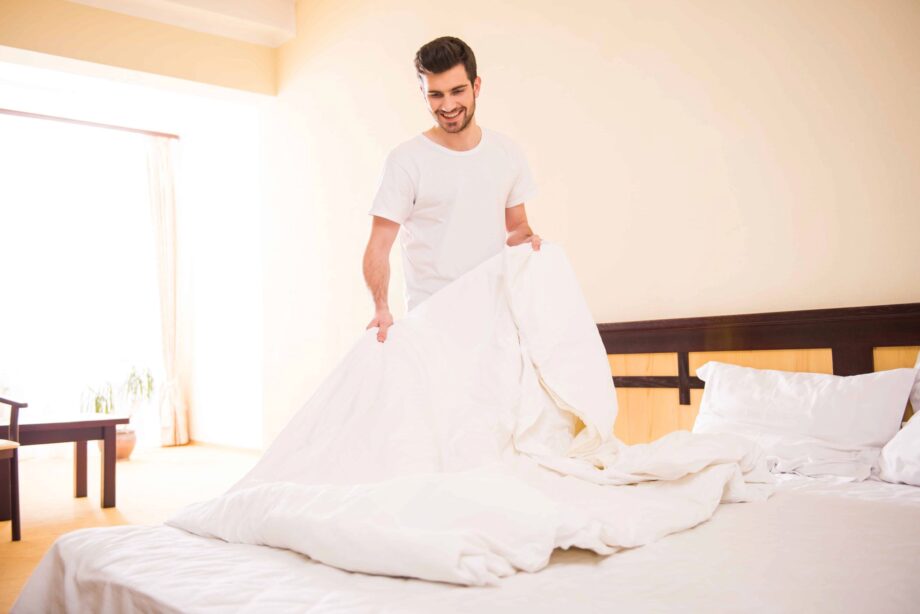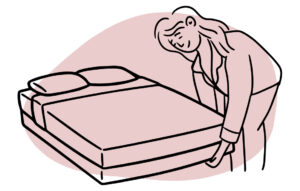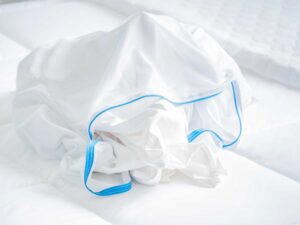How to Clean Your Mattress
Disclosure: By clicking on the product links in this article, Mattress Nerd may receive a commission fee at no cost to you, the reader. Read full disclosure statement.
Every now and then, your mattress needs some extra TLC. About twice a year, to be exact. When’s the last time you gave the place where you spend roughly one-third of your life a thorough cleaning? Refreshing your mattress should be a standard household chore, and it isn’t as difficult as it seems. We’re sharing all our tips for how to clean your mattress below.
Why Cleaning Your Mattress is Important
Mattresses are home to the Invisibles. You know, the creepy crawlies, microscopic residues, and other less-than-lovely substances we don’t want to think about sleeping on. Even if your mattress doesn’t have an obvious issue like bed bugs, large stains, or a vicious odor, many things could be lurking within it. Dust mites, mold, urine, mildew, dead skin cells, blood, and sweat are among the most common contenders, and we’ll spare you the rest of the list.
It’s recommended that you should clean your mattress at least twice a year, but be sure to treat it immediately if issues are noticed prior to scheduled cleanings. If you live in a humid environment, where mattresses are more likely to hold moisture and therefore mildew, etc., you may want to consider cleaning it more often.

How to Clean Your Mattress
There’s no need to hire a professional to deep clean your mattress. Doing so is a relatively easy DIY project and, dare we say, refreshing. Much like that “new car smell,” there’s something pleasant about sleeping on a bed that you know is spick and span.
Here’s what you’ll need for cleaning:
- Baking soda
- Hydrogen peroxide
- Dish soap
- Vacuum cleaner
- Essential oil
Directions
Strip the Bed and Rotate the Mattress
The first order of business is stripping the bed, including the mattress cover (which you should definitely be sleeping on). Toss your sheets and pillowcases in the washing machine, and give the duvet a nice fluff in the dryer. You may even want to drop it off at your local dry cleaners for a deep wash. However, at home is just fine if your washer and dryer are large enough. We encourage using the hottest settings allowed by the manufacturer for all bedding as the heat will help kill any dust mites. Next, rotate the mattress. This is smart to do every six months or so to prevent sagging and encourage the even distribution of weight across the mattress. You may also flip your mattress if it’s allowed by the manufacturer.
Vacuum
Now that the mattress is bare, use a vacuum cleaner to clean the sides and top of the mattress, paying special attention to the seams and crevices for hidden dirt and dust. Be sure the nozzle and upholstery attachment you’re using are completely clean. This will get rid of dander on the surface of the mattress, like dirt, pet hair, dust, or food morsels, that have accumulated since the last cleaning.
Spot Clean
If stripping the bed revealed a host of stains on your mattress surface, don’t fret. Mattress stains are common and relatively easy to treat. How you clean and what you use depends on the type of stain you’re dealing with.
Urine Stains
For set-in urine and liquid stains, dissolve 3 tbsp. baking soda in 8 oz. of hydrogen peroxide. Add a few drops of liquid dish soap, then dab the baking soda mixture on the stain without saturating the mattress.
Blood Stains
For bloodstains, spread a combination of ¼ cup hydrogen peroxide, 1 tbsp. liquid dish soap, and 1 tbsp. salt onto the stain. Allow it to dry, then scrape the dried paste off the mattress and dab any remainder with a rag dipped in hydrogen peroxide.
Deodorize
Once you’ve addressed surface dirt, crumbs, and stains, you can deep clean and deodorize the rest of the mattress. Whether there’s an obvious stench or none at all, this step will leave your mattress looking (and smelling) extra fresh.
Add 10 to 20 drops of your favorite essential oil to a small box of baking soda. Close and shake the box to distribute the oil. Many essential oils work well, especially those with antibacterial properties, like cinnamon and thyme. We like pure lavender oil since it’s known to induce restfulness and relaxation.
Next, sprinkle the mixture over the entire bed and rub the baking soda into the mattress and leave it for at least an hour to let it do its work, which includes ridding the mattress of odors and bacteria.
Vacuum Again, Air Out, and Cover
While you’re waiting for the baking soda mixture to work its magic, use a damp rag to clean the box spring, walls near the bed, and the bed frame. Once the hour has passed, begin vacuuming the mattress again, ensuring all the baking soda has been removed.
Your mattress may need to air out for an hour or two longer. In fact, go ahead and let it air out for the day next to a sunny window if time allows. This helps to dry any moisture that’s built up in its layers. Once the mattress is completely dry, cover it with the mattress protector. This makes future cleanings easier and will protect your mattress from spills, dirt, and more. Make the bed, and you’re ready for a clean night’s sleep!
Keep Your Mattress Cleaner Longer
In addition to seasonal deep cleanings like the one we’ve outlined above, there are a few things you can do on a more regular basis that will protect your mattress from buildup.
- Use a Mattress Cover: Ideally, this cover should be waterproof, acting as a layer of defense against spills, sweat, and bacteria. Most mattress protectors can be easily thrown in the wash.
- Wash Sheets Every 2 Weeks: Bedsheets and linens should be washed at a frequent cadence in hot water. Change them immediately if you’ve been sick, notice a stain, or had a particularly sweaty night of sleep.
- Shower Before Bed: We’ve all had those nights where nothing sounds better than curling up in bed, regardless of whether you’ve just been to the gym, working in the yard, or out walking the dog. But showering before bed is a good habit to get into when it comes to sleep hygiene.
- Keep Eating and Drinking to the Kitchen: With the advent of the TV, it’s much more common for people to snack, drink, or have entire meals in bed. This is a generally unsanitary practice, however, resulting in crumbs, stains, and other unpleasantries.
- Keep Your Bedroom Cool: Did you know that the recommended bedroom temperature for optimal sleep is between 60 and 67 degrees? Not only does this chillier-than-average range induce sleep, but it prevents excessive moisture, mildew, and mold buildup inside the mattress.
When you consider the number of hours spent on your mattress every day, it’s hard to rationalize setting aside this simple chore. A restful night’s sleep on a well-maintained mattress should incentivize you to make this simple regimen a part of your cleaning routine.


